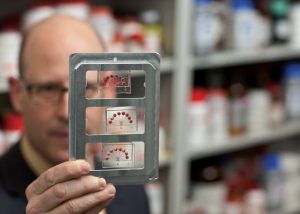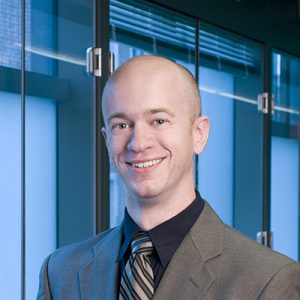CBE Research Labs + Facilities
At the Department of Chemical and Biomolecular Engineering at the University of Pennsylvania, we pride ourselves on our state-of-the-art labs and facilities designed to foster cutting-edge research and innovation. Our labs are equipped with advanced instrumentation for molecular analysis, process optimization, and materials synthesis. We have high-tech computational labs, modern pilot-scale processing units, and specialized areas for bioengineering and nanotechnology research. These resources provide our students and researchers with unparalleled opportunities to explore and solve complex engineering challenges, contributing to advancements in health, energy, and the environment.
Labs
Crocker Research Group
John Crocker Cell Mechanics and Colloidal Self-Assembly Research Group
John’s research concerns the mechanical properties of small objects, ranging from single molecules to living cells. His nanotechnology work is centered on self-assembly, growing useful devices and structures from smaller parts in a biology-inspired, organic fashion. John uses DNA as a programmable adhesive, directing microscopic parts to spontaneously form a crystal-like ordered pattern. His lab has pioneered new methods for quantifying the mechanical response of both single molecules and cells to small forces. Learn more.

Diamond Research Group
Scott Diamond Lab in the Institute for Medicine and Engineering
Scott’s research involves gene therapy, blood systems biology and protease proteomics, microfluidics and biorheology, endothelial mechanobiology, and high throughput screening. The Diamond lab has pioneered the use of nonclassical nuclear localization sequences and cationic steroids for nonviral DNA delivery, printed chemical microarrays for high throughput screening, and stochastic simulation for blood systems biology. Scott is the founding director of the Penn Center for Molecular Discovery, a multi-disciplinary center designed to discover new biologically useful agents. Learn more.

Discher Research Group
Dennis Discher Biophysical Engineering & NanoPolymers Research Group
Dennis’ research efforts in the nano/bio realm range from single protein folding mechanics and stem cell biophysics to polymer-based nano-delivery of drugs. His lab has developed novel degradable cylinders known as filomicelles and also degradable polymersomes that shrink tumors and treat genetic diseases. His lab is also advancing dual mode fluorescence scanning force microscopy methods to add compositional insight to imaging and manipulation of single proteins, complexes, and cells. Learn more.

Gao Research Group
Xue Sherry Gao Biomolecular Engineering Research Group
The Gao laboratory is dedicated to developing highly specific and potent genome-editing tools with broad applications in disease treatment, diagnostics, and novel small-molecule drug exploration. Our research focuses on precision and multiplex CRISPR techniques, offering safe and effective solutions for genetic disorders and enabling microbial and plant genome engineering. Additionally, we are pioneering ultrasensitive viral detection systems to improve diagnostic accuracy and timeliness, especially during pandemics. We aim to advance molecular therapy, genetic engineering, and diagnostics, benefiting the healthcare and biotechnology industries. Learn more.

Hammer Research Group
Daniel Hammer Cell Adhesion and Biophysics Laboratory
Dan applies his research in nanometric soft matter to his studies in biology. Working with colleagues, he has forged polymersomes, membranes made of block copolymers, which are soft, vesicle-like nanoparticles for drug delivery and imaging. Dan has also developed a simulation method of adhesion of receptor-coated nanoparticles to surfaces. The method, Brownian Adhesive Dynamics, once applied to viral binding to cell surfaces, is now being used to understand selectivity and targeting in biological applications of nanoparticles. Learn more.

Kim Research Group
Dohyung Kim Laboratory of Electrochemistry and Interfaces at the Nanoscale
Dohyung’s lab pursues a diverse array of research activities in electrochemistry with the aim to transition to a sustainable economy of renewable electrons. A strong focus is on the fundamental insights gained at the surfaces and interfaces of nanoscale materials. Those insights are to be leveraged to overcome the critical challenges that limit the efficiency and wide applicability of electrochemical processes. Such challenges are the lack of multi-dimensional control for electrochemical reactions, the inability to boost reaction complexity, and the limited understanding and control of solids in electrochemical environments. Learn more.

Lee Research Group
Daeyeon Lee Soft Nanomaterials Laboratory
Daeyeon’s research goal is to extend the basic understanding of soft matter such as colloids, polymers, and nanomaterials to fabricate functional structures with properties designed for advanced applications. The techniques used in his lab include layer-by-layer assembly, microfluidics, optical microscopy, electron microscopy, scanning force microscopy, and dissipative quartz crystal microbalance. Using these techniques, the group studies the interactions of various materials at gas-liquid, liquid-liquid and liquid-solid interfaces. Intermolecular and capillary forces between materials are used to generate functional thin films and microcapsules for applications in renewable energy, sustained release, and encapsulation. Learn more.

Patel Research Group
Amish Patel Research Group
Amish’s research strives to achieve a molecular-level understanding of solvation and transport in aqueous and polymeric systems, with applications ranging from the prediction of protein interactions to the design of advanced materials for water purification and energy storage. It is becoming increasingly evident that water plays an integral role in mediating biomolecular interactions and assembly. The extent to which the inherent structure of water is perturbed by complex biomolecular surfaces, determines the thermodynamics and the kinetics of their assembly. Amish focuses on characterizing this disruption of water structure, with the goal of efficiently predicting protein interactions. Further, how water solvates ions in interfacial and nano-porous environments, bears on the design of membranes for energy-efficient water purification, whereas an understanding of ion solvation and transport in polymeric matrices can help develop better electrolytes for high energy-density batteries.

Radhakrishnan Research Group
Ravi Radhakrishnan Molecular Systems Biology through Multiscale Modeling and High-Performance Computing
Ravi’s research interests lie at the interface of chemical physics and molecular biology. His lab’s goal is to provide atomic and molecular level characterization of complex biomolecular systems and formulate quantitatively accurate microscopic models for predicting the interactions of various therapeutic agents with innate biochemical signaling mechanisms. To do so, they employ several computational algorithms ranging from techniques to treat electronic structure, molecular dynamics, Monte Carlo simulations, stochastic kinetic equations, and complex systems analyses in conjunction with the theoretical formalisms of statistical and quantum mechanics, and high performance computing in massively parallel architectures. Learn more.

Riggleman Research Group
Robert Riggleman Research Group
Rob’s research is focused on providing a fundamental understanding of how the properties of glassy polymers change when they are confined to freestanding, nanoscale thin films. Many experiments have shown that there is a distribution of glass transition temperatures in thin films, and near free surfaces the dynamics are enhanced and the glass transition temperature decreases. His research group is interested in how confinement affects the aging properties of glassy polymers and antiplasticized polymers. Learn more.

Seider Research Group
Warren Seider Process Systems Research Group
Warren’s research is in the fields of chemical process analysis, simulation, design, and control. He is recognized for contributions in phase and chemical equilibria, azeotropic distillation, semi-continuous operations, heat and power integration, Czochralski crystallization, nonlinear control, safety and risk analysis. Warren co-authored the highly regarded and definitive text, Product and Process Design Principles: Synthesis, Analysis, and Evaluation, used in engineering schools and industry around the world. Learn more.

Sinno Research Group
Talid Sinno Computational Materials Science Research Group
Talid’s research program is broadly aimed at the theoretical and computational study of nano and microstructural evolution, particularly nucleation and growth, in condensed matter. He is currently pursuing microdefect formation in crystalline semiconductors, colloidal crystallization of micron-scale particles with tunable interactions, and platelet aggregation in blood. Talid’s lab has developed an extensive suite of simulation tools for studying these phenomena, including large-scale molecular dynamics, multiscale kinetic Monte Carlo, and continuum models. Learn more.

Stebe Research Group
Kathleen Stebe Research Group
Kate’s primary research interests are in non-equilibrium interfaces, with applications ranging from microfluidics to nanotechnology. One aspect of her research program focuses on interfaces between fluids and how surfactants can be used to influence interfacial flows. Other aspects address tailoring of solid-liquid interfaces with applications ranging from patterned electrodeposition to capillary-driven assembly and ordering of nanomaterials. Learn more.

Vohs Research Group
John Vohs Research Group
John concentrates his research on understanding the relationships between the local atomic structure of surfaces and their chemical reactivity. He and his group are developing molecular level descriptions of these important surface phenomena, and using insights obtained in fundamental studies of model systems to design nanoscale materials that have reactivities tailored for applications ranging from selective oxidation catalysis to electrodes for solid oxide fuel cells and other electrochemical devices.

Winey Research Group
Karen Winey Research Group
Karen focuses her polymer nanocomposite research on the development of fundamental structure-property relationships, leading to optimal mechanical, electrical, and flammability properties. Her group controls carbon nanotube composite structure by inventing novel fabrication methods, along with subsequent processing methods that align the nanotubes. Important recent contributions from Karen’s lab include templating crystalline polymers from nanotubes, controlling the electrical conductivity of a composite by the nanotube orientation, and improving both strength and toughness by tuning the nanotube/polymer interface. Learn more.

Facilities
Advanced Chemical Technologies Laboratory, The Unit Operations and Biotechnology Laboratory (Undergraduate Teaching Laboratory)
Director: John C. Crocker
Location: 1st Floor, Towne Building
The Unit Operations and Biotechnology Laboratory is housed within the Advanced Chemical Technologies Lab which was designed to create new knowledge and applications in emerging technologies. It provides a flexible facility where students gain hands-on experience with state-of-the-art instrumentation and experimental techniques in an environment that encourages interaction and collaboration between the faculty and graduate student research enterprise and our undergraduate students.
In the Unit Operations section of the laboratory, undergraduate students conduct experiments about kinetics, reaction engineering, humidification operations, fluid flow, separations processes, and heat transfer. Here, students learn how to conduct experiments using automated processes and digital data acquisition.
In the Biotechnology section of this laboratory, undergraduates conduct bench-scale experiments involving the growth and genetic manipulation of cells; measurements on proteins and DNA; manipulation of biomolecules such as cutting, joining and amplifying DNA, linking biomolecules to solid surfaces, and separating and purifying them.
Catalysis and Fuel Cell Research Laboratory
Director: John M. Vohs
Location: 5th Floor, Vagelos Labs
The catalysis and fuel cell research groups of Prof. Vohs at the University of Pennsylvania share equipment housed in a state of the art research facility that includes a wide range of equipment (listed below) for materials characterization, kinetic analysis of catalytic reactions, fuel cell testing rigs, and surface and interface analysis. Profs. Gorte and Vohs also have a ceramics processing facility that is equipped for synthesis of ceramic materials, tape casting of components for solid oxide fuel cells (SOFC), and high temperature furnaces required for SOFC fabrication. In addition to the facilities in the PI’s labs, the students have access to the equipment in Penn’s Regional Nanotechnology Facility which includes scanning probe microscopes, electron microscopes and an ion scattering spectrometer. Students also have access to Penn’s material characterization facility which contains a range of x-ray diffractometers.
Specific equipment includes the following:
- Vohs Labs: multiple fuel cell testing rigs, 4 impedance spectrometers, ball mill, tape caster, uniaxial press, optical microscopes, 2 BET surface area analysis systems, multiple high temperature furnaces, gas chromatographs, mass spectrometers, a GC mass spec, FTIR, several micro-reactors for catalyst testing, 2 TPD/TGA systems, an XPS spectrometer, an Auger electron spectrometer, and an atomic force microscope.
- Penn Regional Nanotechnology Facility: multiple scanning electron microscopes, multiple transmission electron microscopes, a general purpose atomic force microscope, multiple scanning electron microscopes, and ion scattering facility for RBS.
- Materials Characterization Facility: several powder x-ray diffractometers and a single crystal x-ray diffractometer.
The Nabil Farhat Laboratory, Home of The Biophysical Engineering & NanoPolymers Research Group
Director: Dennis E. Discher
Location: 1st Floor, Towne Building
We study and develop technology with or for: Stem Cells, Differentiation & Matrix; Polymersomes & Filomicelles, chemical physics and use in Drug/Oligo Delivery and Virus Morphology Fundamentals; Molecular Mechanics and Protein Folding in Adhesion, Cytoskeleton, & Nuclear Rheology; Blood Cell Adhesion, Mechanics & Immunocompatability. Methods developed or used range from molecular biology and single molecule AFM to micro-patterned hydrogels, ‘Cys Shotgun’ Mass Spectrometry, and fluorescence ultra-microscopy. Modeling efforts range from statistical physics and continuum mechanics to computation-intensive Monte Carlo and Molecular Dynamics schemes. More information about Dr. Discher’s lab can be found here.
Soft Nanomaterials Laboratory
Director: Daeyeon Lee
Location: Towne M52
Advanced Research Facilities in the Lee laboratory include a Delsa Nano C Particle Analyzer, Ellipsometer, Carl Zeiss HMS Series Slide Stainer, NanoStrata NanoSequenceVI, Quartz Crystal Microbalance, Carl Zeiss Axio Plan II, Nikon Diaphot 300 Inverted Microscope, and Harvard Apparatus PHD Ultra Syringe Pump. More information about the Lee lab and its equipment may be found here.
The Seider Research Offices
Director: Warren D. Seider
Location: 3rd Floor, Towne Building
The Seider research group uses a set of six networked computers, with latest high-end processors, using either Vista or WinXP operating systems. Personal computers are optimized for efficient code compilation and lengthy-run execution. Licensed software available to the group includes the Aspen Engineering Suite 2006.5, Aspen HYSYS, MATLAB 2008a, Superpro Designer, Macromedia Director, Visual C/C++, and Visual Fortran. One workstation is optimized for multimedia development, which includes a Eurorack MX602A mixing board, wind-filtered microphone, and a host of audio and video software for editing and design.
Additional Research Facilities
- Cell Mechanics and Colloidal Self-Assembly Laboratory
Director: John C. Crocker
Location: 5th Floor, Vagelos Labs - The Diamond Lab in the Institute for Medicine and Engineering
Director: Scott L. Diamond
Location: 1st Floor, Vagelos Labs - Cell Adhesion and Biophysics Laboratory
Director: Daniel A. Hammer
Location: Skirkanich Hall - Computational Materials Modeling Laboratory (CMML)
Director: Talid R. Sinno
Location: Mezzanine Level, Towne Building and 5th floor Vagelos Labs
